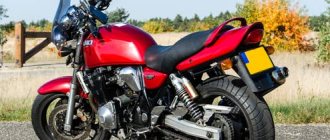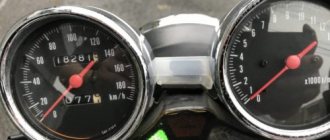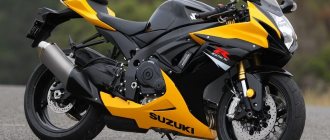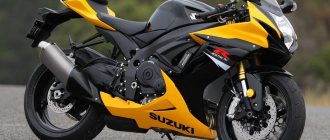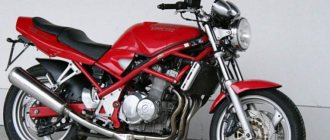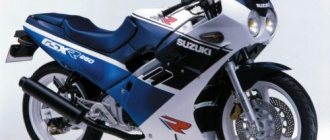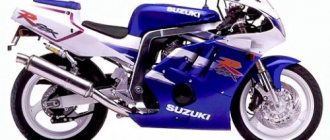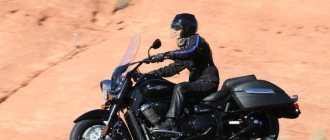Description
The classic Suzuki GSX 1200 Inazuma motorcycle model appeared in 1998 and was produced for the Japanese and European markets until 2002. The motorcycle was based on the engine from the Suzuki GSF 1200 Bandit, which was retuned to increase traction at low speeds. However, it was still the same air-oil power unit with a volume of 1157 cc. see, producing 100 hp. and about 98 Nm of torque, fully available at 4500 rpm. Instead of the Mikuni BST36 and Mikuni BSR36 carburetors used on the Bandit, the Suzuki GSX 1200 Inazuma gets Keihin CVK32 carburetors.
Among the features of the Suzuki GSX1200 Inazuma motorcycle, noteworthy are a steel tubular frame, an aluminum swingarm, a 5-speed gearbox, simple suspension (classic Showa double shock absorber at the rear and a telescopic fork at the front) and 4-piston Brembo brakes.
1999 was the last year of motorcycle production for the Japanese market, and 2001 for the European market. Currently, the Suzuki Inazuma 1200 is widely represented at Japanese auctions of used vehicles, so it is cheapest to bring the model to the Russian Federation from there.
Based on the Suzuki GSX 1200 Inazuma, a domestic Japanese training model was also produced - the Suzuki GSX 400 Inazuma, which had the same frame and chassis, differing only in engine size.
A “junior” version was also produced for the European market - the Suzuki GSX750 Inazuma.
Reviews
Reviews of Suzuki Inazuma 1200:
During its operation, the motor never encountered any serious problems, although I did not receive it in very good condition. I changed all the consumables and did what was required. and calmly drove it 800 km per day. What else is known about him? Many compare him to a bandit, but this is not true. There's nothing like a bandit about him at all. The air-cooled engine seems to be from the sports version of the Katana. It accelerates fun, and due to its heavy weight and geometry it holds the road perfectly. It takes turns easily and holds its trajectory well even on rough asphalt. One 100% plus is the VERY comfortable and large seat. It's a sofa on wheels, which is convenient on long trips. What can be said for sure is that there will be difficulties with spare parts. But if you have money and time, then you can basically order anything you want. Although it is not necessary to order original consumables, many are suitable from other models. It’s difficult for me to compare with other motorcycles, since it’s the first one.
I have a 1998 Inazuma 1200. I drove it for two seasons.
Differences from the bandit carb by 32 mm but with wiring (ignition timing adjustment chtole). As for accelerating to 100.. I don't know when I attached a video camera and then timed it on the timeline when the speed of 100 became 3.15 seconds. maybe because I have a low saddle and it doesn’t jerk but accelerates stupidly, so you can open the gas more boldly without fear of turning over.
Of the breakdowns of the original, only the clutch wears out quickly because the torque is large and lower than on the bandits (98 to 4500). and I also broke the oil cooler myself (they removed it when they hooked the mount and it cracked) and the rear wheel when it flew into the pit at 120. Well, the slider saved me even when I got into a slippery turn at 160, otherwise I would have erased the left crankcase cover. and so the slider is at zero and the lid just started. The steering wheel really broke (it was titanium - it burst when straightened). It seems like I got up and drove 40 km to the city. strong mot. although of course he just rolled on his side for about 70 meters on the asphalt (he was lucky that he fell uphill) without somersaults. well, the geometry was not violated at all. old iron is strong =)
and the consumables are different from the bandit. there are Tokiko or Nissins and here is a Brambo (it is sold in Europe as the GSX1200). The airman here is round and not square like on the bandits. The oil filter is standard, like all engines that are made on the 1100 cc jixer. It seems to fit from the car, but I took it from my family just in case.
Well, it seems like there’s nothing else that can break. except for the sprockets, chains and pads if you are going to ride willy-stoppy from traffic light to traffic light. (although I myself drove almost the same way, only without the wheelie-stoppie =) it was still too heavy for this - 207 kg was when they weighed it at customs without gasoline) for long-distance cruising 140-160 is just right. You can go 220, but then it eats a lot and rocks. in the city it is convenient because of the torque that comes from the bottom.
The classic road bike Suzuki GSX 400 Inazuma model appeared on the market in 1997 and was only available for the domestic Japanese market. Since 1998, the older models of the Inazuma line have appeared on the market - Suzuki GSX750 Inazuma and Suzuki GSX1200 Inazuma. Despite the fact that the Inazuma 400 officially appeared before these models, it was built on their basis - in particular, the reduced-volume engine with gearbox was taken from the Inazuma 750, and the frame and chassis were taken from the Inazuma 1200.
The engine of the Suzuki GSX400 Inazuma is an in-line 4-cylinder air/oil cooled unit with a displacement of 399 cm³, producing a standard 53 hp. power and 36 Nm of torque. The motor is high-speed, with maximum performance at 9500-11000 rpm. This engine was built on the basis of the Inazuma 750 engine, which, in turn, came from the Suzuki GSX-R750 sports model.
Among the features of the Suzuki Inazuma 400, one should highlight its rather rich equipment - KYB rear suspension and 4-piston Brembo front brakes. All this has been transferred unchanged from the older version of the Suzuki GSX1200 Inazuma.
2001 was the last year of production of the model, after which it finally left the market. It so happened that the model existed for only 2 years - in 1997 and 2001. The 2001 models were updated to meet new environmental requirements, receiving a catalyst and carburetors with throttle position sensors.
The main competitors of the Suzuki Inazuma 400 in the class:
Other models of the Suzuki GSX400 series:
Brief history of the model
1998 - start of production and sales of Suzuki GSX1200 Inazuma. Model available only in Japan. Model: Suzuki GSX 1200 Inazuma (Japan). Frame number: GV76A-100001~. Factory designation: GSX1200FSW.
1999 - model available on the European market. Last year of production for the Japanese market. Model: Suzuki GSX 1200 Inazuma (Japan). Frame number: GV76A-101126~ (Japan). Factory designation: GSX1200FSX (Japan); GSX1200X (Europe).
2000 - no significant changes. Model: Suzuki GSX 1200 Inazuma (Europe). Factory designation: GSX1200Y.
2001 is the last year of production. Model: Suzuki GSX 1200 Inazuma (Europe). Factory designation: GSX1200K1.
Specifications
| Model | Suzuki GSX1200 (Inazuma) |
| Motorcycle type | road (street, classic) |
| Year of issue | 1998-2001 |
| Frame | steel tubular |
| engine's type | 4-cylinder, 4-stroke, in-line |
| Working volume | 1157 cm³ |
| Bore/Stroke | 79.0 x 59.0 mm |
| Compression ratio | 9.5:1 |
| Cooling | air-oil |
| Number of valves per cylinder | DOHC, 4 valves per cylinder |
| Fuel supply system | carburetor, 4x Keihin CVK32 |
| Ignition type | transistor |
| Maximum power | 100.0 hp (73.5 kW) at 8500 rpm |
| Maximum torque | 98.0 Nm (10.0 kg*m) at 4500 rpm |
| Transmission | 5-speed |
| type of drive | chain |
| Front tire size | 120/70-ZR17 (58W) |
| Rear tire size | 170/60-ZR17 (72W) |
| Front brakes | 2 discs, 310 mm, 4-piston calipers |
| Rear brakes | 1 disc, 240 mm, 2-piston caliper |
| Front suspension | 43 mm telescopic fork (non-adjustable), travel - 130 mm |
| Rear suspension | pendulum with two shock absorbers (preload adjustment), stroke - 120 mm |
| Motorcycle length | 2140 mm |
| Motorcycle width | 780 mm |
| Motorcycle height | 1100 mm |
| Wheelbase | 1465 mm |
| Seat height | 795 mm |
| Minimum ground clearance (clearance) | 125 mm |
| Acceleration to 100 km/h | 3.0 sec |
| Maximum speed | 221 km/h |
| Gas tank capacity | 18.0 l (including reserve - 3.7 l) |
| Motorcycle weight (dry) | 208 kg – Inazuma 1200 (Japan) 210 kg – GSX1200 (Europe) |
Reviews
Reviews of Suzuki Inazuma 400:
The actual ride quality and driving experience. Well, of course, to a beginner, the hurricane power of a 400 cc Japanese motorcycle, albeit 15 years old, seems like a hurricane, but in fact, behind the first explosion of delight, shortcomings are also visible, but first things first. The motorcycle has been well preserved, showing a mileage of 21+ thousand kilometers, and started up well after replacing the old spark plugs. It really doesn’t like to start when it’s cold; you have to run it with the starter for a long time (all starts must be carried out with the fuel enrichment lever pulled out—the “choke”). The pleasant, not “crazy” sound of the engine’s operation attracts passers-by and neighbors.
The gearbox does not cause any complaints: the shifts are clear and understandable, neutral is caught without difficulty, even with your eyes closed, of course, after some experience in owning a motorcycle. When driving, unfortunately, there are also disadvantages: when driving in city traffic, driving in second is possible up to a maximum of 30 km/h, then the speed rises and the motorcycle starts to work very noisily - as a result, third gear, and then you have to brake, again in 2 pull up, stop, 1 again, etc. In general, not a V-twin, there is little traction at the bottom, but this is already a specificity rather than a disadvantage. gears 2,3,4 are very dynamic, the motorcycle accelerates powerfully, 5th gear is more likely to slow down and maintain speed.
Suspension and damping: a too soft front fork (a national feature of the Japanese) interferes with comfortable and precise cornering (well, installing stiffer springs should solve the problem), changing the oil to a thicker one did not lead to anything. The same soft rear shock absorption, matching the front (by the way, there are two shock absorbers, versus one for the bandit) when turning gives the feeling of a “herring” swaying on the waves. Of course, all this can be solved by investing money in replacing old shock absorbers with hard ones, but this is a very expensive pleasure and, as a result, an unnecessary luxury on a budget motorcycle.
Look and feel. The motorcycle looks very interesting - only owners of Russian motorcycles and hardcore motorcyclists who are tired of modern pathos will understand the retro style. Strangely enough, he primarily attracts the attention of men (!), but girls look at him indifferently. Therefore, a motorcycle is not suitable for young people who want to attract attention. The color of my motorcycle is silver-gray; overall it doesn’t stand out in any way, but this is a plus for balanced people. The feeling of riding a motorcycle is like riding some kind of cruiser: the shiny edges of the dashboard shine and shimmer in the sun, leisurely movement in the city, this masterpiece of the motorcycle industry is demonstrated to the public and arouses their genuine interest.
The seating position is as expected on a road, everyday motorcycle - comfortable and not straining, except that for some reason the rear brake lever causes problems - the leg is very strained due to its bending with the toe forward. Apparently the motorcycle is not designed for tall people, although I’m not one of them (164 cm). Obviously: the pegs are too high, which on the other hand is a plus - the motorcycle can be leaned into a turn more strongly, which does not really fit with the “cotton” suspension - this minus. I can’t say anything about the passenger’s comfort - I haven’t had to transport anyone yet, but observing from the side the position of the tall passenger’s legs on the driver’s elbows makes me doubt it.
The average consumption in a mixed cycle (city-suburb) is 4.5-5.5 liters of 92 grade gasoline. The fuel tank holds 19 liters.
To summarize: This is a very well balanced motorcycle in terms of comfort and dynamics, but loses in handling. Relatively low cost is combined with good performance and high quality.
A good motorcycle for learning and starting a motorcycle life.
I rode my first season on the Inazuma 400. Quite a fast motorcycle. And so a road worker is like a road worker. It has another big plus - the seat is just a sofa - large and comfortable. On long trips this is very noticeable. I received the motorcycle a little shaky, I had to use my hands to fix it. But any maintenance technique requires this. Depends on the initial state. Basically everything was limited to replacing consumables. Access to all components is easy if you have a center stand (I don't have one). In my opinion, the air-cooled engine is only a plus - it is less complex, there is less chance of a malfunction due to an oversight at the very beginning. In the Vladivostok traffic jams it never overheated once all summer. The motorcycle handles well - I got used to it quickly, and by the middle of the season, already in some turns my boot began to catch the asphalt. At low speeds it is more difficult, since the weight is large and the center of gravity is quite high, but it is also acceptable. Consumables. I found everything. Much comes from the bandit, almost everything (except for the cylinders, probably) from the European version of the GSX750Y. This is the same Inazuma. I also have a repair manual for it. The easiest way is to search by catalog numbers from Megazip or somewhere else. In short, I really like the motorcycle. I will only change to Africa. But not next season, that's for sure.
The low price can be explained by the simple design, unpopularity of the model in Russia and great popularity in Japan. I didn’t encounter any so-called pitfalls. An excellent Japanese motorcycle, reliable like everything Japanese. But of course it all depends on the condition of the particular instance.
It’s convenient to go to the valley if you don’t go into shit - this is definitely not an enduro. Although I ride on gravel roads slowly. In general, it all depends on your skills.
There are no problems with the fork at all (pah-pah-pah). I don’t even know what kind of oil was poured in, it hasn’t changed since Japan. My gasoline consumption is from 5 to 7 liters per 100 km. Depends on how you turn it and what quality of gasoline it is. Over the winter I am going to radically clean the air-fuel system, I think the consumption should decrease. In May I filled up the oil with Liquai Molly 10W40 semi-synthetic, and during the season and about 7000 km I didn’t eat a drop.
Manual in English with detailed pictures (weighs 67MB). I do everything according to it myself until everything matches. If you need it, I can use it for soap. And the Inazuma really looks much more interesting than the truck. More about long trips. I installed a front fairing for myself, now it’s absolutely beautiful - it doesn’t blow away at high speeds, the ride has become more comfortable, you get less tired. Sometimes I spent 16 hours a day on the road (I didn’t travel all the time, of course), and my spine didn’t fall into my pants, my butt didn’t hurt, and my arms didn’t fall off. In general, I may not be completely objective, since I only managed to ride on other motorcycles. But overall, I have no complaints about the motorcycle as a road bike.
I started with this myself. The transition period after the Soviet motorcycle industry ended with a general meeting of already experienced bikers, at which it was decided to start riding a more modern motorcycle. The meeting decided to look for a motorcycle with a 400 cc engine. They still said that you would sell it in half a year. I got it in good condition, although the speedometer shows 8000 miles, which is really not true.
At first he seemed like a rocket, but after a few months he realized that everything his friends said was true. I got used to motorcycles and realized that modern motorcycles are far from the Soviet era. Now the motorcycle has been sold and bought with a larger capacity - I don’t understand those guys who just get their license and immediately jump on liter motorcycles.
The wheelbase of the motorcycle is not long and it is pleasant to steer in traffic jams. The first gear is short, there is no wanking clutch - gas again through the same traffic jams. You can drive at idle.
The front fork is weak, sometimes it bounces all the way downhill, the Kulibins suggested installing stiffer springs, but I didn’t bother - I knew I’d sell it.
The engine starts revving only from 9000 rpm. Once I accelerated to 170 - chatting on the road, experiments with speed are over. Moreover, there was a pro-sport exhaust; the previous owner removed the original one and installed a tuned one. The sound is pleasant and at high speeds even fire flew out, but this is in the city... but on the highway more than 120 km the ears simply fall off. When choosing, look at the muffler and listen to the sound at speed; in addition to clogged ears, you will also have to prove your case at the technical inspection, which is very troublesome.
When I found another moto, my friend and I drove 300 km to another city, it was not comfortable to sit in the back, my legs bent too much at the knees, I had to stop and shake my legs and ears. I didn’t waste the oil at all, and the gas mileage was pleasantly surprising. Now I only have time to fill 850 cubic meters.
What I want to say is that the motorcycle is cool in its own way and is very suitable for beginners. In our city, a couple of girls race on these - the bike doesn’t weigh much, apparently they can handle it. Good for getting around the city. With my height of 187, it’s not very comfortable to ride, and it doesn’t look very good from the outside. Well, again regarding gasoline - it is very economical, if you are happy with all the pros and cons, take it. Moreover, the price tag is quite tasty.
Frankly speaking, the first trip was not a success. At first everything was fine and although I missed the gears and the brake pedal, I was driving. It was hard to get underway, since the clutch here is hydraulic and does not work like a cable one. everything was fine until I went straight, where I tried to twist it a little. But as soon as I opened the gas a little, I realized that my clutch was slipping.
Somehow I got to work. I called the technicians and outlined the problem. They suggested changing the clutch. I had to return home and pick up the scooter. While driving to work I got caught in a downpour. Not for the first time, but in the end my mobile phone died. Even though it was in my jacket pocket. For half a day at work I walked around the spendthrift and grieved. Until it dawned on me. I take the 8 key and, holding the bleeder hole with my finger, loosen the screw. Immediately a stream of brake fluid bursts out from under your finger. I tighten it and try the clutch. Everything works. Except for mobile. But I have almost ordered spare parts. I found the service number and hung up. But I had to ride home on a scooter. I left the documents for the money at home.
But the next day everything worked out for me. I came to work on a scooter and, having changed to a motorbike, drove off to register it.
During the day I drove a little less than a hundred kilometers, sat down, stopped missing and began to slowly get a thrill from the acceleration of this Lightning.
